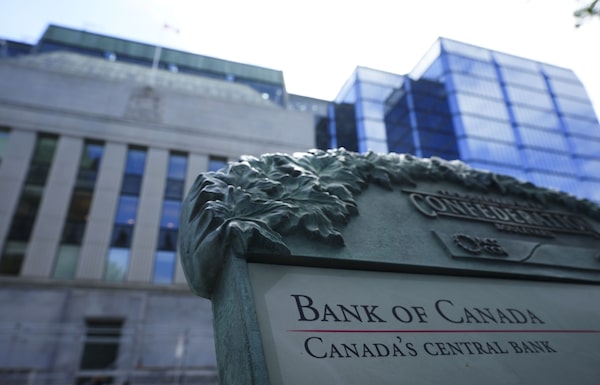
The Bank of Canada raised its key policy rate on Wednesday to a 14-year high of 3.25 per cent.Sean Kilpatrick/The Canadian Press
The Bank of Canada remains adamant that interest rates still aren’t high enough. But the way it said so in announcing its latest rate increase suggests that a change is afoot.
In raising its key policy rate on Wednesday to a 14-year high of 3.25 per cent, the bank laid the groundwork to slow or even pause rate increases later this year. We’re not at the peak of rates, but this may be our first hazy glimpse of it.
The 0.75-percentage-point rate hike itself was precisely what economists anticipated, and the six-paragraph statement accompanying the decision didn’t say much that we didn’t already know. The bank said demand in the Canadian economy is still excessive relative to supply (a condition that fuels inflation), and it concluded that “the policy interest rate will need to rise further.”
But as is often the case in interpreting the Bank of Canada’s rate announcements, it’s necessary to look not only at what the bank says, but how it says it, what it chooses not to say, and how that compares with what it has said before. This announcement contained some intriguing tweaks to its conclusion – the critical paragraph in these news releases – that signal that the bank’s thinking on further rate hikes has evolved.
Compare how different interest rates affect the cost of your mortgage
It dropped the emphasis from July’s concluding paragraph on the economy being “clearly in excess demand,” perhaps a nod to signs of slowing growth and employment. It removed the statement that “the pace of the increase will be guided by the bank’s ongoing assessment of the economy and inflation.” Instead, it’s now talking about “assessing how much higher” rates need to go, “as the effects of tighter monetary policy work through the economy.”
Decisions to change this summary paragraph are not made lightly, and are rarely, if ever, without significance. In turning its emphasis to assessing the impact of its increases with an eye on how much further it needs to raise rates, the bank signalled that it is approaching time to take a breather – something it has said all along that it might do.
Given that the bank still asserts that rates must rise further, we’ll likely have one more increase (probably a smaller one) in October. Assuming the bank is happy with how the economy and inflation evolves between now and then, the path would then be clear for the bank to take a break and let its policy moves play out for a while.
Still, we have a couple of competing ideas that emerge from Wednesday’s rate statement: one, that further rate increases are necessary to tame inflation; and two, that it might soon be time for a pause in rate hikes. Can the bank have both views at the same time? Sure it can.
First, if you think about what the Bank of Canada is trying to achieve, and how it thinks about interest-rate levels in terms of their net economic effect, it shouldn’t be surprising that it’s still talking about the need to take rates higher.
The bank wants to slow domestic demand that it continues to say is overheated, in order to ease more ingrained inflation pressures that threaten to persist even as prices for gasoline and other commodities ease. But before Wednesday, the key rate of 2.5 per cent was right in the middle of the 2-to-3-per-cent range that the central bank considers “neutral” – in which rates neither stimulate nor restrain the economy. All the bank had achieved with all of its rate hikes up to that point was to remove the monetary policy stimulus put in place early in the COVID-19 crisis, and stop actually stoking the economy (and, by extension, inflation) with its interest rates.
If 3 per cent is the top end of “neutral,” then the new rate of 3.25 per cent is the bare minimum that can be considered “restrictive,” i.e. high enough to restrain economic activity. With inflation running at 7.6 per cent in August – more than triple the bank’s target of 2 per cent – and the bank’s core inflation measures averaging 5.3 per cent, this does not feel like a situation in which the bare minimum will do. The central bank, evidently, agrees.
But now that the bank has gotten interest rates to a level it believes will actually apply a brake to the economy, it is wary about stomping down too hard and/or too fast. Anything it does from here will, by definition, cause damage. As the bank wades deeper into restrictive rates, it will want to do so more gradually and carefully, with more time built in to assess the impact. Failing to do so could result in an overshoot of policy tightening, sending the economy tumbling into recession.
We should get a better idea of how the bank strikes a balance between these two ideas on Thursday, when senior deputy governor Carolyn Rogers gives the bank’s post-announcement speech and news conference discussing its decision and updating its economic views. But there’s no question that Wednesday’s rate hike moved the rate cycle into a new, and necessarily slower, phase – one that certainly brings the bank a step closer to determining where and when the peak is for interest rates. Between now and the next decision in October, we may begin to get a clearer view of what that peak looks like.
Your time is valuable. Have the Top Business Headlines newsletter conveniently delivered to your inbox in the morning or evening. Sign up today.
 David Parkinson
David Parkinson